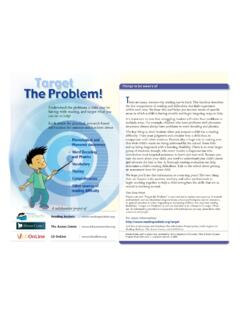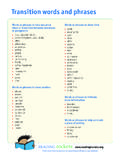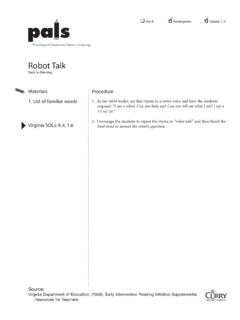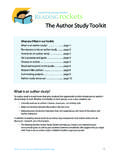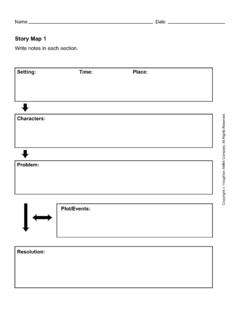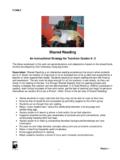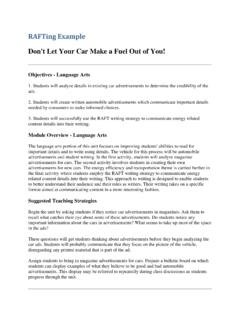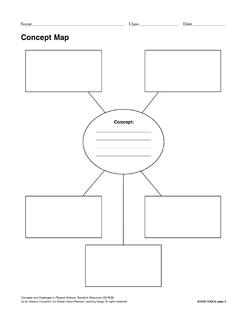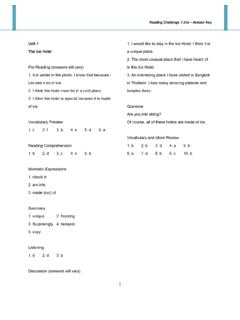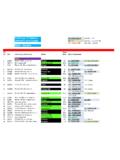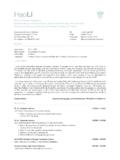Transcription of The Dyslexia Toolkit - WETA
1 The Dyslexia Toolkit An Essential Resource Provided by the National Center for Learning Disabilities Table of ContentsPart One: The BasicsChapter 1: What Is Dyslexia ?..2 Chapter 2: Common Warning Signs of Dyslexia in Children Pre-K-Grade to 3: Common Warning Signs of Dyslexia in Children in Grades 3 to 4: Common Warning Signs of Dyslexia in 5: Common Warning Signs of Dyslexia in College Students and 6: Testing for 7: Helpful Dyslexia 8: Video: What Is Dyslexia ?..22 Part Two: Living and Learning with Dyslexia Chapter 9: Can Audio or Digital Books Improve Your Child s Learning Outcomes?..23 Chapter 10: Accommodating Students with 11: Homework 12: How Self-Advocacy Can Lead to Innovation: An Interview with Ben 13: Dyslexia : An Obstacle, Not a 1 What Is Dyslexia ? As with other learning disabilities, Dyslexia is a lifelong challenge that people are born with. This language processing disorder can hinder reading, writing, spelling, and sometimes even speaking. Before we go further, let s take a look at how Dyslexia can manifest itself in writing: This text was taken from our interview with Stanford University graduate Ben Foss.
2 You ll find the interview on page 34. Dyslexia is not a sign of poor intelligence or laziness. It is also not the result of impaired vision. Children and adults with Dyslexia simply have a neurological disorder that causes their brains to process and interpret information is criticla they you experiment with being public about who you are and see what ifeels like not to hide on this issues. It canbe scary to tell people that you are of part of a lable that is associated with being lazy or stupid. I have fel this sting. The day I turned in mt thesis at Stanford Law School, a classmate laughed outloud at the registers office bcause I had the term learning disabilities in my title. "They can;t articulate anything!" I looked at him and explained that I had a learning disabili-ties. He was embarrassed and occurs among people of all economic and ethnic backgrounds. Often more than one member of a family has Dyslexia . According to the National Institute of Child and Human Development, as many as 15 percent of Americans have major troubles with of what happens in a classroom is based on reading and writing.
3 So it's important to identify Dyslexia as early as possible. Using alternate learning methods, people with Dyslexia can achieve Are the Effects of Dyslexia ? Dyslexia can affect people differently. This depends, in part, upon the severity of the learning disability and the success of alternate learning methods. Some with Dyslexia can have trouble with reading and spelling, while others struggle to write, or to tell left from right. Some children show few signs of difficulty with early reading and writing. But later on, they may have trouble with complex language skills, such as gram-mar, reading comprehension, and more in-depth can also make it difficult for people to express themselves clearly. It can be hard for them to use vocabulary and to structure their thoughts during conversation. Others struggle to understand when people speak to them. It becomes even harder with abstract thoughts and non-literal language, such as jokes and of these effects can have a big impact on a person's self-image.
4 Without help, children often get frustrated with learning. The stress of dealing with schoolwork often makes children with Dyslexia lose the motivation to continue and overcome the hurdles they Are the Warning Signs? Dyslexia has different warning signs in people of different ages. See pages 5-16 for more information on signs of Dyslexia in different age groups. Everyone struggles with learning at times. Learning disabili-ties such as Dyslexia , however, are consistent and persist over time. The following lists are a general guide, for identifying Dyslexia . Our Interactive Learning Disabilities Checklist is an additional resource to consider. Finally, be aware that some of the "symptoms" listed also apply to other learning disabilities as well as other disorders such as Attention-Deficit/Hyperactivity Disorder (AD/HD), which often co-exist with you or your child displays several of these warning signs, don't hesitate to seek help. Check off the warning signs that apply to your child, and take the list to the professional(s) who you consult.
5 With proper identification and support, your child will be better able to succeed in school, the workplace, and in life. No one knows your child better than you do, so trust your instincts if you think help is needed. 3 How Is Dyslexia Identified?Trained professionals can identify Dyslexia using a formal evaluation. This looks at a person's ability to understand and use spoken and written language. It looks at areas of strength and weakness in the skills that are needed for reading. It also takes into account many other factors. These include family history, intellect, educational background, and social Is Dyslexia Treated?It helps to identify Dyslexia as early in life as possible. Adults with unidentified Dyslexia often work in jobs below their intellectual capacity. But with help from a tutor, teacher, or other trained professional, almost all people with Dyslexia can become good readers and writers. Use the following strategies to help to make progress with Dyslexia : Expose your child to early oral reading, writing, drawing, and practice to encourage development of print knowledge, basic letter formation, recognition skills, and linguistic awareness (the relationship between sound and meaning).
6 Have your child practice reading different kinds of texts. This includes books, magazines, ads, and comics. Include multi-sensory, structured language instruction. Practice using sight, sound, and touch when introducing new ideas. Seek modifications in the classroom. This might include extra time to complete assignments, help with note taking, oral testing, and other means of assessment. Use books on tape and assistive technology. Examples are screen readers and voice recognition computer software. Get help with the emotional issues that arise from struggling to overcome academic and writing are key skills for daily living. However, it is important to also emphasize other aspects of learning and expression. Like all people, those with Dyslexia enjoy activities that tap into their strengths and interests. For example, people with Dyslexia may be attracted to fields that do not emphasize language skills. Examples are design, art, architecture, engineering, and 2 Common Warning Signs of Dyslexia : Pre-K to Grade 2 While Dyslexia is most often formally identified in school-age children, signs of Dyslexia can frequently be detected in you re concerned about your child, review the following checklist of common warning signs of Dyslexia in children in pre-kindergarten to grade 2.
7 For at least the past six months, my child has had trouble:Language:Learning the alphabet, numbers, and days of the weekNaming people and objectsSpeaking precisely and using a varied, age-appropriate vocabularyStaying on topicGetting or staying interested in stories and booksLearning to speak (delayed compared to his peers)5 Understanding the relationship between speaker and listenerPronouncing words correctly (Example: says mazagine instead of magazine )Learning and correctly using new vocabulary wordsDistinguishing words from other words that sound similarRhyming wordsUnderstanding instructions/directionsRepeating what has just been saidReading:Naming lettersRecognizing letters, matching letters to sounds, and blending sounds when speakingLearning to read as expected for his/her ageAssociating letters with sounds, understanding the difference between sounds in wordsAccurately blending letter sounds within wordsRecognizing and remembering sight wordsRemembering printed wordsDistinguishing between letters and words that look similarLearning and remembering new vocabulary wordsKeeping one s place and not skipping over words while reading Showing confidence and interest in readingWriting:Learning to copy and write at an age-appropriate levelWriting letters, numbers, and symbols in the correct orderSpelling words correctly and consistently most of the timeProofreading and correcting written workSocial-Emotional:Making and keeping friends Interpreting people's non-verbal cues, body language, and tone of voiceBeing motivated and self-confident about learning6 Other.
8 Sense of direction/spatial concepts (such as left and right)Performing consistently on tasks from day to day7 CHAPTER 3 Common Warning Signs of Dyslexia : Grades 3 to 8 Are you concerned that your elementary or middle school child isn t learning, communicating, or relating to others as successfully as his or her peers? Does your child especially struggle with reading? Is it affecting your child s confidence and motivation?If so, the following checklist of common warning signs of Dyslexia in children in grades 3 to 8 may help clarify your at least the past six months, my child has had trouble:Language:Understanding instructions or directionsRepeating what has just been said in proper sequenceStaying on topic and getting to the point (gets bogged down in details)Naming people and objectsSpeaking with precise, accurate language, proper grammar, and a varied vocabularyDistinguishing between words that sound similar8 Pronouncing words correctlySpeaking smoothly, without much halting or use of "filler words" (like "um")RhymingUnderstanding humor, puns, and idiomsReading.
9 Reading age-appropriate content with good fluencyReading aloud or silently with good understandingFeeling confident and interested in readingRemembering sight words and other printed wordsLearning and remembering new vocabulary wordsAccurately analyzing unfamiliar words (tends to guess instead)Reading words and letters in the correct order, seldom reversing or skipping over themUnderstanding word problems in mathWriting:Mastering spelling rulesSpelling the same word consistently and correctlyWriting letters, numbers, and symbols in the correct orderProofreading and correcting self-generated work Expressing ideas in an organized way (older children)Preparing/organizing writing assignments (older children)Fully developing ideas in writing (older children)Listening and taking notes at the same timeSocial-Emotional:Participating in a peer group and maintaining positive social statusInterpreting people's non-verbal cues, "body language," mood, and tone of voiceDealing with peer pressure, embarrassment, and expressing feelings appropriatelySetting realistic social goalsMaintaining positive self-esteem about learning and getting along with othersMaintaining confidence about fitting in with his classmates and other peers9 Other:Learning/remembering new skills; relies heavily on memorizationRemembering facts and numbers Sense of direction/spatial concepts (such as left and right) Performing consistently on tasks from day to day Applying skills from one situation to another Learning new games and mastering puzzles10 CHAPTER 4 Common Warning Signs of Dyslexia : Teens Are you concerned because your teen is struggling with academic learning in school?
10 Have you noticed any social awkwardness or a tendency to keep a distance from peers? Does lack of motiva-tion seem to be a problem? Do you worry about whether low self-esteem is taking the joy out of learning?These may all be signs of a not-yet-identified learning disability (LD) such as Dyslexia . Look over the following checklist of common warning signs of Dyslexia in teens. For at least the past six months, my teen has had trouble:Language:Speaking fluently (not haltingly) and precisely, using a rich vocabularyUnderstanding instructions/directionsUsing correct grammar and vocabularyUnderstanding the relationship between speaker and listener; participating in conversation appropriately11 Staying on topic and getting to the point (gets bogged down in details)Summarizing a storyDistinguishing between words that look or sound similarUnderstanding non-literal language such as idioms and jokesReading:Reading with speed and accuracy for one's expected grade levelReading aloudReading without losing one's place or substituting/skipping over wordsRecognizing sight wordsUsing word analysis (not guessing) to read/learn unfamiliar wordsFinding enjoyment and confidence in readingWriting:Spelling accurately and consistentlyProofreading and editing written workPreparing an outline for written workExpressing ideas in a logical, organized wayFully developing ideas in written workSocial-Emotional.
